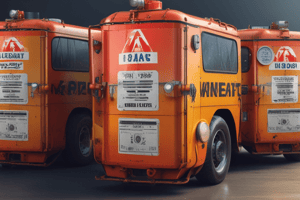Podcast
Questions and Answers
What subsidiary hazard label is required for corrosive liquids with oxidizing properties?
What subsidiary hazard label is required for corrosive liquids with oxidizing properties?
- Class 8
- Class 3
- Class 5.1 (correct)
- Class 6.1
What is the requirement for storage and transportation procedures for oxidizing corrosive substances compared to corrosive substances alone?
What is the requirement for storage and transportation procedures for oxidizing corrosive substances compared to corrosive substances alone?
- No difference in requirements
- They must be less stringent
- They are prohibited from storage and transportation
- They must be more stringent (correct)
Under what condition can other corrosive liquids (Class 8) be stored together without strict segregation?
Under what condition can other corrosive liquids (Class 8) be stored together without strict segregation?
- If they are all in the same packaging
- If they are from the same manufacturer
- If they are all in solid form
- If they are not capable of reacting dangerously with each other (correct)
What do subsidiary hazard labels on a package indicate?
What do subsidiary hazard labels on a package indicate?
Under what condition can hazardous materials belonging to the same class be stored together without rigid segregation?
Under what condition can hazardous materials belonging to the same class be stored together without rigid segregation?
What is the exception granted for hazardous materials belonging to the same class?
What is the exception granted for hazardous materials belonging to the same class?
What must be ensured when implementing segregation measures based on a subsidiary hazard label?
What must be ensured when implementing segregation measures based on a subsidiary hazard label?
Study Notes
Hazard Labeling and Storage
- Corrosive liquids with oxidizing properties require an Oxidizer subsidiary hazard label.
- Storage and transportation procedures for oxidizing corrosive substances are more stringent than those for corrosive substances alone, due to the added risk of combustion.
- Other corrosive liquids (Class 8) can be stored together without strict segregation if they are compatible and do not react with each other.
- Subsidiary hazard labels on a package indicate the presence of additional hazards, such as oxidizing properties, that require special handling and precautions.
- Hazardous materials belonging to the same class can be stored together without rigid segregation if they are compatible and do not react with each other.
- The exception to this rule is if the materials have different subsidiary hazard labels, which would require segregation.
- When implementing segregation measures based on a subsidiary hazard label, it must be ensured that the materials are separated by a sufficient distance or barrier to prevent reactions or adverse interactions.
Studying That Suits You
Use AI to generate personalized quizzes and flashcards to suit your learning preferences.
Description
Learn about the proper segregation of hazardous materials during transportation and the relevant regulations. Understand the requirements for subsidiary hazard labels and their significance in indicating additional hazards.




